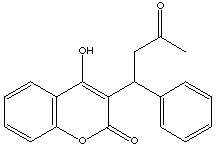Warfarin
- 4-Hydroxy-3-(3-oxo-1-phenylbutyl)coumarin
- 3-(alpha-Acetonylbenzyl)-4-hydroxycoumarin
- 2H-1-Benzopyran-2-one, 4-hydroxy-3-(3-oxo-1-phenylbutyl)

Warfarin | |
| |
| Formula | C19H16O4 |
| Structure |  |
| Description | Colorless crystals. |
| Uses | Rodenticide for norway rats & for house mice. |
| Registry Numbers and Inventories. | |
| CAS | 81-81-2 |
| EC (EINECS/ELINCS) | 201-377-6 |
| EC Index Number | 607-056-00-0 |
| EC Class | Toxic for reproduction Category 1; Toxic; Dangerous for the Environment |
| RTECS | GN4550000 |
| RTECS class | Agricultural Chemical and Pesticide; Reproductive Effector; Human Data |
| UN (DOT) | 3027 |
| Merck | 12,10174 |
| Beilstein/Gmelin | 1293536 |
| Beilstein Reference | 5-18-04-00162 |
| RCRA | P001 |
| EPA OPP | 86002 |
| Swiss Giftliste 1 | G-1444 |
| Canada DSL/NDSL | DSL |
| US TSCA | Listed |
| Austrailia AICS | Listed |
| New Zealand | Listed |
| Japan ENCS (MITI) | Listed |
| Korea ECL | Listed |
| Properties. | |
| Formula | C19H16O4 |
| Formula mass | 308.33 |
| Melting point, °C | 167 - 168 |
| Boiling point, °C | 515 |
| Vapor pressure, mmHg | 2E-11 (25 C) |
| Vapor density (air=1) | 10.6 |
| Solubility in water | 20 mg/L |
| pKa/pKb | 4.50 (pKa) |
| Partition coefficient, pKow | 2.52 |
| Heat of vaporization | 82.9 kJ/mol |
| Hazards and Protection. | |
| Storage | Store at away from heat and open flame. Do not store near feeds and foodstuffs and keep away from children, domestic animals, pets, or wildlife. |
| Handling | All chemicals should be considered hazardous. Avoid direct physical contact. Use appropriate, approved safety equipment. Untrained individuals should not handle this chemical or its container. Handling should occur in a chemical fume hood. |
| Protection | Wear appropriate protective gloves, clothing and goggles. |
| Respirators | Wear positive pressure self-contained breathing apparatus (SCBA). |
| Small spills/leaks | Do not touch spilled material. Eating and smoking should not be permitted in areas where it is handled, processed or stored. For small spills: sweep onto paper or other suitable material. Place in an appropriate container and burn in a safe place. Large quantities may be destroyed by dissolving in a flammable solvent (e.g., alcohol) and atomizing in a combustion chamber. |
| Stability | Contact with strong oxidizers may cause fires and explosions. |
| Incompatibilities | Incompatible with the following: Strong oxidizers. |
| Fire. | ||||
| Flash Point,°C | 188 | |||
| Fire fighting | (Non-Specific -- Poison B Solid) Wear full protective clothing and self-contained breathing apparatus.(Non-Specific -- Poison B Solid) Extinguish fire using agent suitable for type of surrounding fire. Use alcohol foam, carbon dioxide, or dry chemical. | |||
| Fire potential | Contact with strong oxidizers may cause fires and explosions. | |||
| Hazards | Contact with strong oxidizers may cause fires and explosions. Toxic gases and vapors (e.g., carbon monoxide) may be released in heating to decomposition. Avoid strong oxidizers. | |||
| Combustion products | Fire may produce irritating, corrosive and/or toxic gases. | |||
| Health. | |
| Exposure limit(s) | TLV: ppm; 0.1 mg/m3 (as TWA) (ACGIH 1991-1992). OSHA PEL: TWA 0.1 mg/m3 NIOSH REL: TWA 0.1 mg/m3 NIOSH IDLH: 100 mg/m3 |
| Poison_Class | 2 |
| Exposure effects | Intracranial hemorrhage and hematomyelia may occur following warfarin therapy. The use of warfarin during pregnancy has been associated with teratogenic effects. <br>Fetal intraventricular hemorrhage has been reported following maternal ingestion of warfarin. <br>Craniofacial, musculoskeletal, skin, eye, gastrointestinal, and cardiovascular developmental abnormalities have been observed in the offspring of women administered warfarin sodium during pregnancy. <br>Intrauterine fetal demise, intrauterine growth retardation, and hemorrhagic disease of the newborn have been reported following administration of warfarin sodium to pregnant women. |
| Ingestion | Abdominal pain, vomiting, gastrointestinal bleeding, hemoptysis, and bloody or melenotic stools may occur. |
| Inhalation | Highly toxic, may be fatal if inhaled, swallowed or absorbed through skin. Effects of contact or inhalation may be delayed. |
| Skin | Warfarin may be absorbed through the skin and cause systemic poisoning. |
| Eyes | See Inhalation. |
First aid | |
| Ingestion | Seek medical assistance. |
| Inhalation | Move victim to fresh air. Apply artificial respiration if victim is not breathing. Do not use mouth-to-mouth method if victim ingested or inhaled the substance; induce artificial respiration with the aid of a pocket mask equipped with a one-way valve or other proper respiratory medical device. Administer oxygen if breathing is difficult. |
| Skin | Remove and isolate contaminated clothing and shoes. Remove material from skin immediately. Immediately flush with running water for at least 20 minutes. For minor skin contact, avoid spreading material on unaffected skin. |
| Eyes | Immediately flush with running water for at least 20 minutes. |
| Transport. | ||
| UN number | 3027 |  |
| Response guide | 151 | |
| Hazard class | 6.1 | |
| Packing Group | I; II; III | |